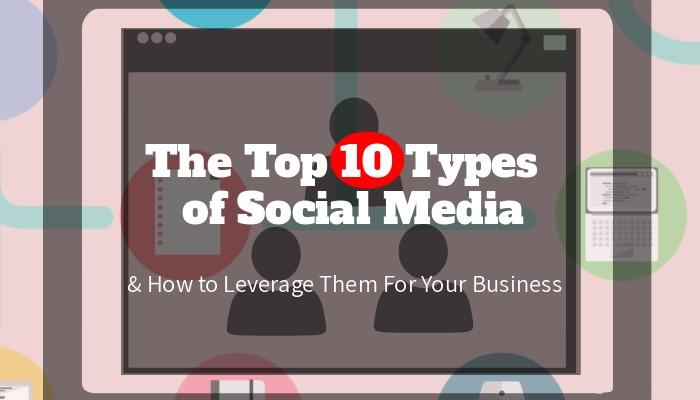Social Media Types
You can likely recognise all of the biggest social media platforms. You probably already use many of them or at least have an account. But when it comes to business, there is a lot more to the big social media platforms. To gain the most from these popular platforms for your business, you need to understand the types of social media and how to leverage them for your business.

Social Media Business Uses
These types of social media essentially offer users a way to share what’s on their mind. But what they choose to share and how they share it will vary widely. Using a social networking site like Facebook will feel different than browsing a forum on Reddit. As a business owner interested or engaged in digital marketing, these two platforms will present different opportunities.
The good news is that most types of social media are quite versatile. They offer organic content marketing opportunities and paid ads. However, most types of social media are also very busy. Users are inundated with content of all kinds, so marketing to them is tricky. If your content, paid or organic, doesn’t “click” with them, they’ll find something else that will in a matter of seconds. We will go over the ways you can efficiently leverage the social media landscape and ensure your voice is heard.
Table of contents:
- ● Social Media Types
- ● Social Media Business Uses
- ● The Changing Media Landscape
- ● Types Of Social Media
- ● Social Networks
- ● Photo Sharing
- ● Video Sharing
- ● Audio Sharing
- ● Blogging & Publishing Networks
- ● Discussion Forums
- ● Consumer Review
- ● Bookmarking sites
- ● Social Shopping
- ● Sharing economy networks
- ● Which Types Will Cost Me Money?
- ● Advertising Tips For Social Media
The Changing Media Landscape
There are several major changes that social media has been going through. We delve into those changes in-depth in our Social Media Trends report. We’d recommend you read it to understand the most powerful and important trends to be aware of, regardless of your unique business proposition.

Social Media Trends
What you need to know right now is that in all mediums, authenticity and interactivity are crucial. Also, major social media platforms are being pressured into suppressing disinformation, especially within the health and finance industries.
When it comes to your social media content, again, paid or organic, unique, well-designed content that users find valuable will be rewarded. But the first step is capturing the attention you need to engage audiences.
Whether you’re writing a blog, launching podcasts or videos, or anything else, your first impression matters. It’s the difference between users who click and users who just continue scrolling along. The first things they will see are:
- Images or thumbnails
- Titles, headlines, or your first line of copy
Images
Your company likely has a logo and a conceptual design. Now, you just need to fit those designs into the social media spaces you will be active on. For example, if you want to get active marketing on Facebook, your designs must fit into the standard sizes for Facebook’s:
- Profile images
- Cover images
- Banners
- Ad displays
With the Facebook example, there are two ways you can do this. First, you could make a fresh design with the design elements your business already uses. Or, you could use existing images and resize them to meet the Facebook image requirements. If you skip this step, your Facebook images may lack the quality they deserve.
Design Wizard has templates for Facebook and other major platforms’ image sections. You can also use the resizing tool to quickly change your images’ sizes while retaining their quality.
Headlines
Facebook doesn’t put headlines on posts, nor do many other social media platforms. But the text at the top of your post will always make or break user engagement. This goes for titles, headlines, or introductory copy.
Fortunately, you have the option of testing multiple headlines on major social media platforms. You can experiment with different copy, as well as different imagery. Once you find out what works, spend more money circulating that version of your ad. But still experiment, as you never know what copy will work best until you try it all.
Types Of Social Media
Let’s go over the major types of social media and their implications for businesses advertising online.

Social Networks
Examples:
When you hear “social media”, the first platforms that come to mind will likely be social networks. Facebook, Twitter, and LinkedIn are super-popular platforms that function, at least in part, as social networks.
People use social networks to connect with people they’ve met and explore their interests. They can keep up with their social circle and discuss the things they care about with others.
How to leverage this type for your business needs?
Among the content that users view on social networks, there is content created by brands. People can follow your business’s pages, places where you can post interesting content or launch paid ad campaigns. In short, social networks help businesses:
- Raise brand awareness
- Engage with interested users
- Perform market research
- Build a deeper relationship with customers
- Offer customer service through comments or private messaging
- More…
Social networks can be a gold mine for businesses when they’re used properly. The social mapping app is a valuable tool for modern business. It allows you to keep an eye on what’s happening in your industry, who’s talking about you and how they’re word-of-mouth advertising works by monitoring other people using it as well.
When it comes to organic marketing, remember to post useful and/or interesting content. These kinds of posts work best when users either:
- Build an emotional connection with your storytelling
- Feel they have gained insights that benefit their lives
So, share insights on developments in your industry. Share stories that your customers would care about. Be authentic and provide them with what they’re looking for.
Social networks can offer you a lot of insight into what your customers think. You can find this information:
- In the comments they leave
- In their messages
- Through tools like Facebook’s analytics

Photo Sharing
Examples:
- Snapchat
Many social media platforms allow you to share photos. But some are almost entirely dedicated to it. People use these platforms to share their experiences through photos. They share photos that showcase appearances, experiences, or opinions on various topics.
What separates this type of social media from other examples is the focus on and amplification of images. When people browse Instagram on their phone, the focus is almost entirely on the images. The same can be said of Snapchat and our other examples.
Photo sharing social media allows you many organic and paid marketing tools. Before users even read your captions, they can read a lot in your images. Images often include headlines or even more text that leads into the caption. You can also include infographics, illustrations, and all sorts of useful information in your images.
How to leverage this type for your business needs?
If you want to share images as a part of promoting your company, platforms like Instagram will give you a great opportunity to do so. Photos are a great option, but you can accompany your most attractive posts with infographics and illustrations. Just remember that people are consuming dozens of images every minute, so yours needs to stand out. Showcase insights and show off your products in the most aesthetic way possible.
One great way to use photo sharing social media for business is encouraging user-generated content. Ad campaigns can include encouragement for users to take pictures with a product and share it with others. You can take advantage of appropriate hashtags to further increase your reach.
The easiest way to get started on these social media sites is to start with the right images. You can use templates to make sure your image fits in the social media platform you’re going to use. For example, Facebook ad templates ensure your image is sized properly for an ad on the Facebook news feed. After that, give your images the unique touches they need to stand out and communicate your offer. You can add text in many sizes, fonts, and colours. You can also edit images for transparency, brightness, contrast, and much more. Keep editing and testing your images to ensure you get the greatest possible returns on photo sharing social media.

Video Sharing
Examples:
- TikTok
- YouTube
- Vimeo
Video sharing social media was revolutionised by YouTube. Now, video content is one of the most popular ways for people to interact online. Users view videos to learn new things or to be entertained. Many people showcase aspects of their life using video sharing platforms by sharing cute or interesting snippets of their time.
How to leverage this type for your business needs?
Video sharing platforms offer you some of the best opportunities to personalise your products. You can show an online audience how your products work over a more engaging medium. Good production value is important and can help make your presentation more entertaining. Mixing marketing content and entertainment is a great way to achieve success with video sharing social media.
Video sharing sites are a great place to learn more from your audiences. People will get a closer look into what you have to offer, and many will share their thoughts in the comment section. The advertorial format is a great way to educate and engage your audience. If they have strong thoughts on your presentation, many of them will share that with you.
When you’re making videos for your company, attracting attention is important. Your titles can be “clickbait”, but make sure they don’t display promises your video doesn’t fulfil. After that, your thumbnail is a powerful clickbait opportunity. You can use Design Wizard to edit the correct-sized image for YouTube and other sites’ thumbnails.

Audio Sharing
Examples:
- Clubhouse
- Soundcloud
- Last.fm
Audio sharing social media platforms like SoundCloud can be used to share audio files. Users go to these sites to find and share music, podcasts, audiobooks, and other media. Many musicians try to kick-start a musical career or hobby using this type of social media.
How to leverage this type for your business needs?
Audio sharing platforms won’t benefit all types of businesses equally. But in some industries, audio files are a great tool for marketing purposes.
You can share educational audiobooks, theme songs, and other audio media on audio sharing social media sites. Audiobooks are increasing in popularity, especially among young adults. While people don’t use audio sharing sites to browse for products as much as the other types of social media, there are certainly unique opportunities to take advantage of.

Blogging & Publishing Networks
Examples:
- Tumblr
- Medium
- WordPress
People use blogging and publishing social media like Medium and Tumblr to learn and to teach others. Users share stories and ideas and readers discover, read, comment on, and share them. The range of content you will find on these sites is massive. People will publish information, opinions, experiences, and much more.
Blogging and publishing platforms get a lot of traffic that is more focused. If people are taking the time to search for and read articles, they are fairly invested in the topic they are searching for.
How to leverage this type for your business needs?
These social media platforms provide a free and simple path to promoting your own content. If your marketing strategy doesn’t already include content marketing, these platforms are a great place to start.
Written content can be used to increase the visibility of your business. It can also be used to turn your business into a thought leader within your niche. It also ties in neatly with a broader strategy that includes the other types of social media covered here. You can share your blogs on all your social media channels, which in turn increases the value you can provide on social networks. Then, SEO allows you to organically promote your website at the same time.
Importantly, if you can create long-form but useful content, blogging and publishing can increase your online reach extremely far and at a minimal cost. Sites like Medium naturally do quite well at SEO (popping up higher in the major search engines’ results pages). If you cover topics relevant to your industry in-depth and use the right language, people will have an easier time stumbling upon your business when searching for information online.

Discussion Forums
Examples:
- Quora
- Stack Overflow
Discussion forums are collections of chat rooms where people can discuss any subject. They’re one of the oldest forms of social media, as they date back to the earliest stages of the internet. People go to them to discuss hobbies, news and opinions. When users have a problem they aren’t sure they can solve, they may go onto a discussion forum to ask other users for advice.
Social media is a hotbed of discussion, and forums can attract passionate people. They are a great resource for anyone trying to find out more about a topic. You can find new opinions and discover passionate and honest opinions that you won’t find elsewhere.
How to leverage this type for your business needs?
Blatant advertising will not work on discussion forums. There is marketing potential, but you have to be careful to keep your ads and informative posts separate.
The real business use that discussion forums provide is market research. Discussions on forums are normally anonymous, and many users will be far blunter there than they would be on a social network like Facebook. Places like Reddit and Quora are great for finding out how people really feel about your industry, the problems it solves, and the issues surrounding it.
Lastly, discussion forums are a go-to destination for many people who are thirsty for knowledge. When you ask Google a question, the answers that pop up are often forum threads. See what people are thinking, and offer informative answers to their burning questions.
Interest-Based Forums
You can narrow down your research by going to interest-based forums. These forums are the ones that are relevant to your industry. They’re where people go to discuss problems, solutions, and of course products.

Consumer Review
Examples:
- TripAdviser
- Trust Pilot
- Yelp
Consumer Review sites are social media platforms where people share feedback about goods or services. They allow people to go over the pros and cons of anything they purchase, usually within a specific industry. Think of Yelp for restaurants as an example.
These platforms provide research material for other consumers. Many people use them in their decision-making process when deciding which business to go to. But they are also a useful resource for businesses.
How to leverage this type for your business needs?
If you want to hear the blunt, honest reality of your business and your industry, consumer review platforms are where you need to go. First of all, the people who go to them are most often the ones who are the most dissatisfied. But you can also find honest, calm reviewers who will casually point out the best aspects of a product.
You can use customer review social media to delve into the biggest problems customers have in your industry. This treasure trove of information can be used to make adjustments to your business and your marketing strategy. You can equip yourself to speak directly to the problems that customers are passionate about.
Many consumer review sites will have information on your products, whether you’re aware or not. In some cases, these platforms also allow businesses to respond to complaints. You can use them to delve to the bottom of any issues with your products and to find out more about the average consumer’s problems with your industry.

Bookmarking sites
Examples:
- StumbleUpon
- Dribble
- Digg
“Bookmarking” platforms are used to discuss, share, and save materials for a variety of content. These sites feature interesting posts, or at least those that are the most popular.
The go-to example of bookmarking social media is, without a doubt, Pinterest. Pinterest is essentially a digital pinboard, and it features a lot of “hacks” and how-to guides for interested users. Often, sites like Imgur and Pinterest morph into something bigger, as they feature communities of contributors, commenters, and interested users.
How to leverage this type for your business needs?
To successfully use bookmarking social media for business, your site needs to be bookmark-friendly. You then need to optimise your headlines and images for the bookmarking platforms’ feeds. This allows them to discover and share your content. Then, your content to appear on bookmarking social media sites.
Like image-sharing social media, appearances are everything on bookmarking platforms. People often browse them for memes and entertainment. So, make your images creative, but simple enough for people to be able to grasp in a crowded space filled with the most popular content.

Social Shopping
Examples:
- Facebook Marketplace
- Instagram Shoppable Posts
- WeChat Shop
Social shopping is a combination of traditional eCommerce and social networking platforms. Social networks like Facebook have pushed the concept forward with tools like Facebook Marketplace. Users go there to shop, much like they would on Amazon. But they can also leave reviews and talk to others about the products that interest them. It could be argued that social shopping is a fusion of several of the types of social media we’ve covered.
How to leverage this type for your business needs?
Social shopping is another great research tool for businesses selling online, but differently than our last few examples. You can use them to keep up with trends in different industries. You can also follow discussions surrounding shopping tips.
Another great use for social shopping social media is fostering better brand awareness. They allow businesses to sell products as well, which makes them an invaluable tool. The best part is that these platforms actually double as social media and eCommerce sites. They are meant for shopping, but with an added social element. This makes them a worthwhile opportunity as they increase in popularity.

Sharing economy networks
Examples:
- AirBNB
- Uber
- TaskRabbit
Sharing economy networks connect users with providers of products or services. They connect and facilitate transactions, typically while maintaining many social media tools such as reviews and chats. You may also hear them referred to as “collaborative economy networks”.
How to leverage this type for your business needs?
Most sharing economy networks focus on a niche industry. If you happen to fall under that industry, these social media platforms will open a new funnel for you to sell your products or services. Depending on the platform you choose, you may be able to:
- Advertise
- Research competition
- Buy
- Sell
- Trade
You’ve probably already heard plenty about the big platforms we’re using as examples. But there are sharing economy networks for many other things as well. There are networks for dog sitting, parking, and much, much more.

Which Types Will Cost Me Money?
Most of the social media platforms we’ve covered are free, to an extent. But there are uses that we’ve gone over that will cost you.
Sharing Your Content For Free (Organic Marketing)
Typically, posts made with a personal or business account are free across platforms. Your followers will be able to see everything you post and interact with those posts. However, your reach is limited because the only way organic posts will increase your following is if they’re shared by your current followers. To seriously increase your reach or to advertise real products and services, you’ll need to pay.
Marketing On Social Media
Advertising on Facebook, Instagram, and other platforms will require you to start an ad campaign. These will allow you to reach audiences with posts labelled “sponsored” or something similar. That way you can get into the feeds of users who haven’t followed you yet.
To make each paid dollar count, you have to pay even more attention when paying to reach cold audiences.
Advertising Tips For Social Media
Regardless of how and where you advertise on social media, there are a few tips you should always follow.
Grabbing attention is hard and the stakes are high whether you’re running paid ads or just creating organic content. But you have control over the success social media can contribute to your business. It all starts with grabbing attention and creating an ideal first impression.
Design Wizard has all the tools you need to create the right images. You can start by selecting a template with the correct size for your social media images. This ensures you start assured that your image will be displayed with the best quality possible.

You can edit your images to align with the content of all your posts and paid ads. Adding creative text is easy and takes just a few clicks. From there, you can choose dozens of fonts and colours.

It’s important to take advantage of all the relevant resources available to you. The trend of businesses moving online doesn’t look like it will change course anytime soon. So, while it’s never too late to start taking full advantage of the most powerful social media types, it’s certainly never too early!



